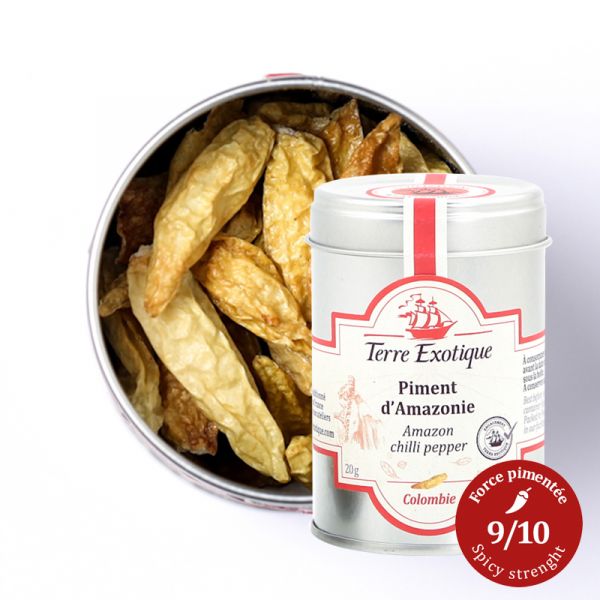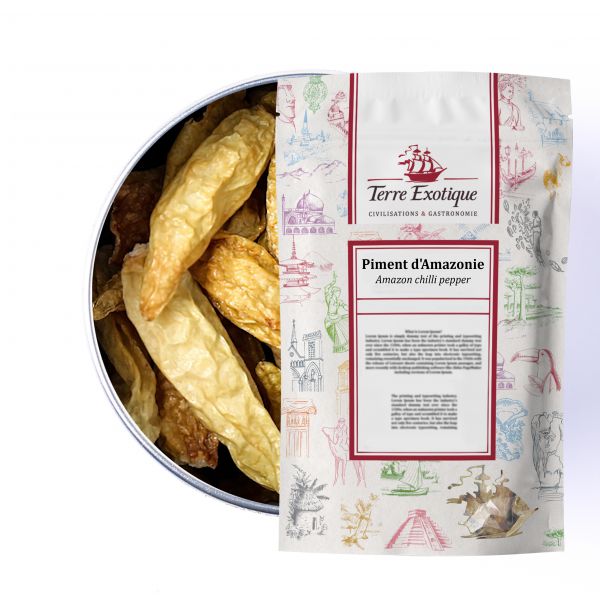



How to Use Amazonian Pepper in Cooking?
Some recommendations regarding Amazonian Pepper
Amazonian pepper is very powerful. It is essential to use it with certain precautions. Avoid handling it with bare hands. Prefer to use gloves to avoid any contact with mucous membranes, especially the eyes. Handle it delicately.
How to use Amazonian Pepper according to the desired spiciness?
Amazonian Pepper can be used and consumed in various ways, depending on the desired spiciness. Like other peppers, the spiciness of Amazonian Pepper concentrates in the seeds.
To add a moderate spiciness to your dishes, you can:
- - use it whole, letting it infuse in your preparations;
- - remove the seeds and internal membranes, and finely chop the flesh to integrate it into your preparations;
- - rub it on foods like meat to enhance their flavor.
To add a powerful spiciness to your dishes, you can:
- - cut it into small pieces while keeping the seeds to obtain a potent spiciness, then add it to your preparations or on your dishes;
- - cook it to reveal its strength. The longer it cooks, the spicier it will make your dish. Therefore, you should add it more or less early in the preparations, depending on the desired profile;
- - dry it in the oven for 30 to 45 minutes, then grind it into pepper powder;
- - rehydrate it, finely slice it, and add it to a preparation.
Our culinary usage suggestions for Amazonian Pepper
While Amazonian Pepper should be used sparingly, it can be used without restraint in cooking. In the overseas territories, it is consumed in the same way as pepper. It can be used in starters, main courses, desserts, or beverages. You can use it to spice up sauces or soups, add flavor to simmered dishes, meat dishes, or dips. Amazonian Pepper can also enhance a chili con carne and give it character.
The Aromas of Amazonian Pepper
In the mouth, Amazonian Pepper has fruity flavors. It possesses subtle acidity and citrus notes, reminiscent of Tabasco pepper. Indeed, these two peppers belong to the same species of peppers. Delicate yet potent, it can be used for various purposes.
Its spiciness level is 9/10 (volcanic) on the Scoville scale; its heat is slightly less intense than Cayenne pepper.
Amazonian Pepper, an Exceptional Pepper
How does Amazonian Pepper grow?
The botanical name of Amazonian Pepper is Capsicum frutscens. It belongs to the same botanical species as Tabasco pepper. It is harvested slightly before its optimal maturity, which gives it its yellow color and imparts its tangy notes. Delicate drying allows it to retain this color as well as all its organoleptic qualities.
What is the origin of Amazonian Pepper?
This pepper is native to Colombia, more precisely from the highly fertile Amazon basin, one of the richest natural reserves on Earth. Hence, this volcanic pepper derives its name from the mythical river flowing through this region: the Amazon River.
Colombia's Role in Pepper Culture
Colombia is named after the explorer Christopher Columbus. He was the one who brought the first varieties of hot peppers to Europe. The cultivation of peppers in Colombia is ancient, dating back over 1500 years. Drawings attributed to pre-Columbian civilizations have been found in some wells accessing ancient burial chambers, between 600 and 900 AD. During that time, peppers were used as pigments for the drawings.
Click here to learn more about peppers
| Allergen | Absence |
|---|---|
| Native country | COLOMBIE |
| Genus and botanical species | Capsicum frutescens |
| Ingredients | Amazon chilli pepper |
| TRACES EVENTUELLES D'ALLERGÈNES | céleri, sésame, moutarde, fruits à coques. |
 Français
Français 